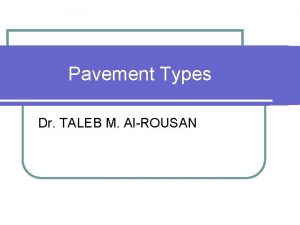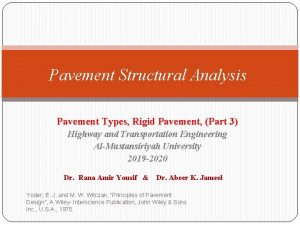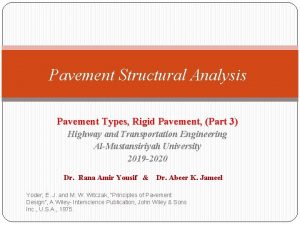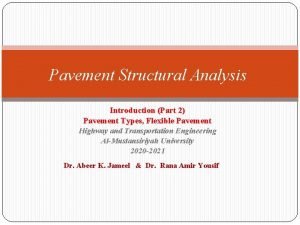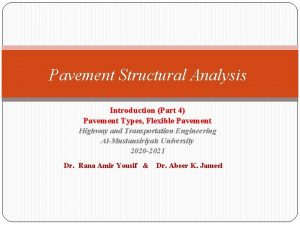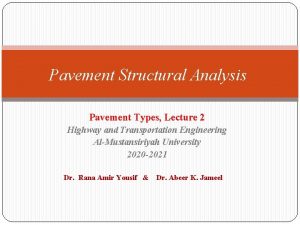Pavement Structural Analysis Introduction Part 3 Pavement Types










- Slides: 10

Pavement Structural Analysis Introduction (Part 3) Pavement Types, Flexible Pavement Highway and Transportation Engineering Al-Mustansiriyah University 2020 -2021 Dr. Rana Amir Yousif & Dr. Abeer K. Jameel

Flexible Pavement Full - depth asphalt pavements: � constructed by placing one or more layers of Hot Mix Asphalt (HMA) directly on the subgrade or improved subgrade. � This concept was conceived by the Asphalt Institute in 1960 � It is generally considered the most cost-effective � dependable type of asphalt pavement for heavy traffic. � This type of construction is quite popular in areas where local materials are not available. � It is more convenient to purchase only one material, i. e. , HMA, rather than several materials from different sources, � thus minimizing the administration and equipment costs.

Flexible Pavement According to the Asphalt Institute (AI, 1987), full-depth asphalt pavements have the following advantages: � They have no permeable granular layers to entrap water and impair performance. � Time required for construction is reduced. � On widening projects, where adjacent traffic flow must usually be maintained, full-depth asphalt can be especially advantageous. � When placed in a thick lift of 4 in. (102 mm) or more, construction seasons may be extended. � They provide and retain uniformity in the pavement structure. � They are less affected by moisture or frost. According to limited studies, moisture contents do not build up in subgrades under full-depth asphalt pavement structures as they do under pavements with granular bases. Thus, there is little or no reduction in subgrade strength.

Flexible Pavement Typical layers of a flexible pavement Seal Coat: Seal coat is a thin surface treatment used to water-proof the surface and to provide skid resistance where the aggregate in the surface course could be polished by traffic and become slippery.

Flexible Pavement Tack Coat: �Tack coat is a very light application of asphalt, �usually asphalt emulsion diluted with water. �It provides proper bonding between two layers of binder course �must be thin, �uniformly cover the entire surface, and set very fast. �It does not require penetrating into the underlying course.

Flexible Pavement Prime Coat: �Prime coat is an application of low viscous cutback bitumen to an absorbent surface like granular bases which binder layer is placed. � It provides bonding between two layers. �Unlike tack coat, prime coat penetrates into the layer below, plugs the voids, and forms a water tight surface.

Flexible Pavement Surface course: � It is the layer directly in contact with traffic loads � generally contains superior quality materials. � They are usually constructed with dense graded asphalt concrete (AC). � It provides characteristics such as friction and smoothness. It must be tough to resist the distortion under traffic and provide a must smooth skidresistant riding � It be and water proof to protect thesurface, entire base and sub-grade from the weakening effect of water. It will prevent the entrance of excessive quantities of surface water into the underlying base, sub-base and subgrade,

Flexible Pavement Surface course:

Flexible Pavement Binder course � This layer provides the bulk of the asphalt concrete structure. � Its chief purpose is to distribute load to the base course � the binder course generally consists of aggregates having less asphalt and doesn't require quality as high as the surface course, � so replacing a part of the surface course by the binder course results in more economical design.

Flexible Pavement
 Flexible pavement
Flexible pavement Standard axle load for pavement design
Standard axle load for pavement design Differentiate between flexible and rigid pavement
Differentiate between flexible and rigid pavement Pavement structural design
Pavement structural design Arches and cables
Arches and cables Typical cross section of flexible pavement
Typical cross section of flexible pavement Jointed plain concrete pavement
Jointed plain concrete pavement Types of rigid pavement
Types of rigid pavement Introduction to the structural units
Introduction to the structural units Introduction to the structural units
Introduction to the structural units Chapter 1 introduction to the structural units
Chapter 1 introduction to the structural units





